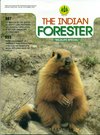Human-sloth Bear Conflict: Causes and Mitigation in Kota, Rajasthan, India
DOI:
https://doi.org/10.36808/if/2018/v144i10/139572Keywords:
Melursus ursinus, Conflicts, Endangered, Interviews, ForestsAbstract
The sloth bear (Melursus ursinus), is the most dangerous wild animal due to its' unpredictable behaviour and often attacks on human in forests. The present investigation represents human-sloth bear conflicts, as per standard methods and survey. The results suggested that, most of the casualties can be reduced by restricting human entries into sloth bear habitats, avoiding camping and housing in their habitats especially near water sources. Further road accidents were common in the study area due to National Highway near the forest area. The scientific management in collaboration with local inhabitants will support the conservation of this species.References
Charoo S.A., Sharma L.K. and Sathyakumar S. (2009). Asiatic Black Bear-Human Conflicts around Dachigam National Park, Kashmir. Technical Report. Wildlife Institute of India, Dehradun 51pp.
Chauhan N.P.S. (2006). The Status of sloth bear in India. In Understanding Asian bears to secure their future, Japan Bear Network, Ibaraki, Japan. 26-34 pp.
Cowan I.Mc.T. (1972). The Status and Conservation of bears (Ursidae) of the world-1970. Inter. Conference on Bear Research and Management. 2 342-367.
Garshelis D.L., Ratnayeke S. and Chauhan N.P.S. (2008). (IUCN SSC Bear Specialist Group). c2008 [cited 2 July 2016]. In: Melursus ursinus. The IUCN Red List of Threatened Species: e T13143A3413440.
http://projecttiger.nic.in/WriteReadData/PublicationFile/Tiger_Stat us_oct_2010.pdf
http://www.iucnredlist.org/details/summary/13143/0
Jhala Y.V., Qureshi Q., Gopal R. and Sinha P.R. (2011). Status of tigers, co-predators and prey in India. New Delhi and Dehradun: National Tiger Conservation Authority, Government of India, New Delhi, and Wildlife Institute of India. Report No. TR 2011/003.
Rajpurohit K.S. and Krausman P.M. (2000). Huan-sloth bear conflicts in Madhya radish, India. Wildlife Society Bulletin, 28 393399.
Sathyakumar S., Kaul R., Ashraf N.V.K., Mookerjee A. and Menon V. (2012). (Ministry of Environment and Forests, Government of India Wildlife Institute of India, Wildlife Trust of India, Central Zoo Authority, Government of India). National bear conservation and welfare action plan; 2012. Technical report. India: Ministry of Environment and Forests, Wildlife Institute of India and Wildlife Trust of India.
Singh H.S. (2001). Natural heritage of Gujarat. Gujarat Ecological Education and Research Foundation, Gandhinagar, India. 262 pp.
Vyas R., Tomar R.S. and Arya M. (2014). Call of the Wild Sanctuary Asia Bear necessities. Hornbill Article. 84-87 pp.
Yoganand K., Rice C.G., Johnsing A.J.T. and Seidensticker J. (2006). Is the sloth bear in India secure? A preliminary report on distribution, threats and conservation requirements. J. Bombay Nat. Hist. Soc., 103(2-3): 172-181.
Yoganand K., Rice C.G. and Johnsingh A.J.T. (2013). Sloth bear: Melursus ursinus. In: Mammals of South Asia (Johnsingh AJT, Manjrekar N, editors) Universities Press. 1: 438-456.
Downloads
Downloads
Published
How to Cite
Issue
Section
License
Unless otherwise stated, copyright or similar rights in all materials presented on the site, including graphical images, are owned by Indian Forester.





